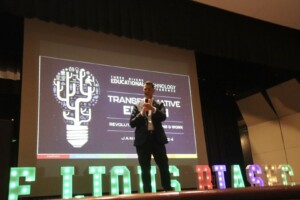Is Text-to-Speech Technology Beneficial for Struggling Readers?

Using text-to-speech educational technology to help struggling readers is becoming more common in today’s classrooms.. However, some may feel that using this technology, which reads text aloud as students follow the highlighted text on the screen, is a ‘crutch’. Teachers, parents and even students themselves may see this not as a tool, but as cheating.
But recent light being shed on the question shows that not only is text to speech not a ‘crutch’, but it is indeed an invaluable tool to help students improve results and importantly, stay motivated.
Holding to Universal Design for Learning (UDL) principles, presenting content in auditory and visual formats provides learners with a variety of ways to access text, allowing each student to learn in the way that is personally most effective. This bimodal presentation of content improves comprehension and academic results. Wise, Ring, and Olson (2000) found that text to speech supports decoding, which frees the reader to focus on meaning, rather than the act of reading, encouraging an understanding of concepts and facilitating dialogue and writing.
But as Dr. Michelann Parr, Schulich School of Education at Nipissing University, Canada points out, this assistive technology has benefits: increasing motivation and self-esteem. Research shows,that belief in oneself and choice in what and when to read are motivators for children. Text-to-speech technology supplies these, facilitating independence since the student can read on his own what he chooses, and self confidence, as he is successful in both reading the text and understanding grade-level content with the others in his class.
“For those students who are frustrated because of a lack of decoding skills and fluency,” observes Dr Parr, “Text to speech is a confident internal voice, a support for comprehension and a valuable lifelong tool.”
This is where text-to-speech education technology, can eliminate decoding issues and allow struggling readers to participate with their peers in grade level activities.
Teaching reading through traditional methods develops the ability to decode and make the connection between sounds and letters. However, in some cases this is not effective for students who have difficulty with processing the information. Decoding can take a huge amount of effort and by the time the word is successfully decoded, the child may no longer have the energy to understand or use the content. These students risk becoming frustrated, or withdrawfrom text and cease to read. This can cause them to lose contact with any text, undermining their reading development and the acquisition of knowledge and understanding in all subjects.
Text-to-speech technology offers these students hope. The technology decodes the text for the disabled learner. In this way struggling readers can work autonomously at grade-level, giving them the chance to set aside decoding challenges and move on to high-level thinking. Disabled readers are no longer stuck with basic decoding and low-level activities. They are given new and exciting opportunities to engage and make meaning from content and develop understanding and study skills.
While having a student read on their own is the goal, it is important to be realistic that not all students will read with a high level of fluency. “Most of the students with whom I worked could decode with between 90 and 95% accuracy, but their fluency rates were incredibly low—some of them were reading at 32 words a minute in order to decode with 95% accuracy,” explains Doctor Parr. “When they got to the task of meaning-making and comprehension, they had no energy left. They could not remember what they had read.”
In the future, struggling readers will be able to read what they need on a daily basis (medicine bottles, signs, menus, etc.), but for in-depth learning, struggling readers have far greater potential if given the support of text-to-speech technology.
Without the enabling tool of assistive technology these students would be denied access to content that allows them to learn at the same rate as the other students.
“Would you take a guide dog from an individual with a visual impairment?” questions Doctor Parr. “I offer that it is not our role to take something away, especially if it is enabling student engagement and self-efficacy. As readers, it is tough for us to fully understand, but if you introduce it, if you encourage it, and if you see the promise, you’ll be amazed at just how far your students can go.”
Teachers, parents and students can use solutions such as ReadSpeaker’s TextAid, Kurzweil’s Firefly or TextHelp’s Read&Write. They can even access a free trial of the complete ReadSpeaker text-to-speech solution and try it for themselves.
The real debate the community should be holding is why are we not making more of an effort to make this high efficacy educational technology available to all students in all learning environments.
For more, check out:

Amy Fowell is a consultant in education marketing. Follow ReadSpeaker on Twitter, @ReadSpeaker.





Randj
I totally agree. As a teacher, I've never understood the logic of testing a student at their grade level if they are reading below grade level. Are we testing the standard or the reading level?
Daniil
Thanks for getting together the research in this comprehensive way. Just wanted to add another piece of great software that is aimed at just that: "Reading and writing for everyone"!
http://www.assistiveware.com/product/wrise (Mac only)
Norbert
I have tried many text-to-speech softwares out there and I find it really difficult to concentrate if the Reader has robotic sound.
For now the best I could find was Text to Speech from iSpeech.org and it supports many languages.
http://www.ispeech.org/text.to.speech
Do you know any other "natural sounding" ones?
Replies
Romeo Zegna
yes, Neospeech